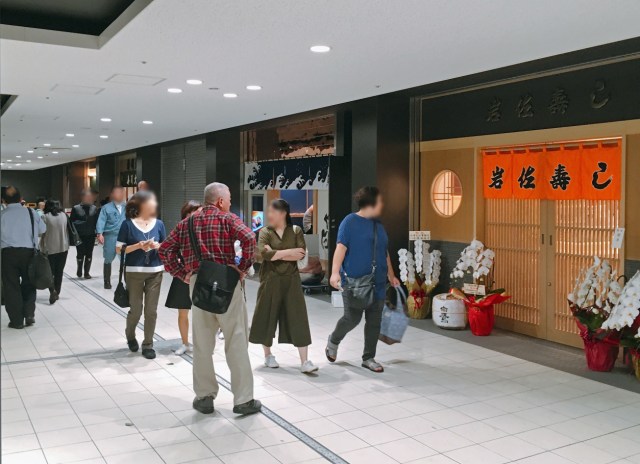
We pay a visit to the new market to find out if the restaurants from Tsukiji are still as good as they used to be.
On 11 October, the world’s largest wholesale fish and seafood market opened for business at Toyosu after making the move from their 83-year-old location at Tsukiji, located roughly 2.3 kilometres (1.4 miles) away.
While a large majority of media reports focused on issues concerning the fishmongers and the new wholesale operations at the facility, another group of tenants were also adjusting to the move, as some of the market’s famous restaurants were due to open their doors at the new complex as well.
One of the most famous of these restaurants was Sushi Dai, often touted as the best place to enjoy fresh sushi in all of Tokyo. Our roving reporter Mr Sato, who’s dined at a number of Tsukiji sushi establishments in the past, decided to pay a visit to the new complex to see how the new restaurants were faring with the move.
When he arrived, he found that the restaurants were now split up over three different areas at Toyosu: Four were in the Fruit and Vegetable Market building, 13 in the Management Offices building, and 22 in the Fish Intermediate Wholesale Market building.
Well-known restaurants like Senrikan and Sushi Dai are now located in the Intermediate Wholesale Market building, so Mr Sato made a beeline for this area to see what it was like. When he arrived, he saw that, as always, Sushi Dai had a long line of customers waiting outside it. Unlike the old Tsukiji location, though, where people had to stand in line before entering, the restaurant now had small round stools for customers to use.
It’s busy here, so if you’re planning on getting in, be sure to get in early in the morning. By 11 a.m., when this photo was taken, Sushi Dai had already stopped receiving customers for the day.
As Mr Sato walked around the complex, looking for another place to dine at, he noticed something very different about Toyosu — all restaurants, and the facility itself, is now non-smoking. However, smokers are still catered for with special enclosed smoking rooms.
As an area that caters to fishmongers and customers alike, there’s more to eat than just fish here, and one of the most famous restaurants you’ll come across is Nakaei, which serves up delicious curry meals.
Seeing as he’d missed out on getting into Sushi Dai, Mr Sato decided to fill his belly with curry instead, and despite the restaurant being full when he arrived, it wasn’t long before he was shown to a seat and given a menu.
▼ Menu options include Indian and Japanese style curries, as well as an option for beef stew.
And if you’re extra hungry, the restaurant offers an extra serving of shredded cabbage for 50 yen (US$0.45), an extra serving of curry roux for 100 yen, and an extra spicy option for 100 yen. And they also have an unusual miso soup with egg for 100 yen.
Mr Sato ordered one of the restaurant’s most famous dishes, the Aigake Curry, which allows you to choose two curries from a choice of Indian curry, Japanese beef curry, or Hayashi Rice beef stew. Mr Sato opted for the Indian and Hayashi Rice, which was delivered within ten minutes of making his order.
For Mr Sato, this dish was reminiscent of a Showa-era (1926-1989) meal, with its Japanese-style western flavours and rice intertwined with cabbage in every bite. Our reporter was pleased to find that the warming flavours of the Showa period can still be enjoyed at Toyosu, even as the Heisei era is set to come to a close when the current Emperor abdicates the throne next year.
Whether or not your palate is fine-tuned enough to discern the nuances of period cooking, the curry selections here are definitely worth trying, and Mr Sato also recommends ordering a cup of their egg miso soup as well. The soft flakes of warmed egg create a smooth and creamy texture, with the umami of the miso giving way to a peppery kick at the end.
And because it was something he’d always done before at Tsukiji, Mr Sato decided to end his meal with a visit to Iwata, a coffee house that’s been serving cups of Joe to fishmongers and their customers for decades.
Much newer than their previous store at Tsukiji, Iwata still served up the same great coffee that Mr Sato had always enjoyed, and when he recognised that the waitress had also worked at Tsukiji, he struck up a conversation with her and asked how she was finding the new store. She said it was bigger, but more tiring because their Tsukiji location only had one long counter, whereas this space now has more seating.
Mr Sato then turned to the elderly couple next to him, to ask them what they thought about the new cafe. They told him that they loved it and hoped others would too, with their wish being to help fishmongers and establishments in the complex flourish in future.
With these true Tokyo locals frankly telling him their feelings, he once again felt a true sense of Showa-era nostalgia and knew that the real spirit of Tsukiji would live on, in spite of the market’s new shiny surroundings.
It was the perfect way to end his time at the new Toyosu market, and Mr Sato wholeheartedly recommends everyone pay it a visit. The market may have changed location, but the people who made it what it was are still here, keeping old traditions alive like so many generations did before them.
Photos © SoraNews24